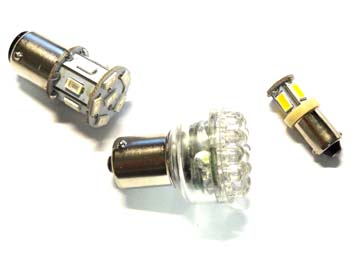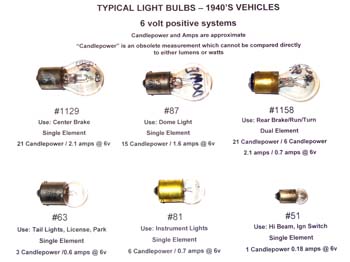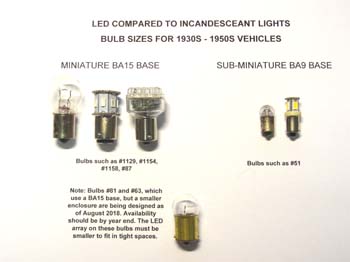By Phil Lapin / Technical Coordinator
LED Light Conversion for Vintage Autos
by Phil Lapin / CPPC Technical Coordinator
Click on an image to see a larger version.
 This article delves into a subject I am personally involved in at present. I have completely rewired our 1942 Plymouth P14S, and am replacing all of the incandescent light bulbs with modern LED versions of those lights. It is a work in progress, but I will share with you what I have learned to date.
This article delves into a subject I am personally involved in at present. I have completely rewired our 1942 Plymouth P14S, and am replacing all of the incandescent light bulbs with modern LED versions of those lights. It is a work in progress, but I will share with you what I have learned to date.
6 Volt Positive Ground. The focus of this article is upon 6 volt positive ground systems - and upon vehicles from the mid 1930s up into the 1950s. I am not talking about headlights, but rather all other bulbs. There are many LED lights for other classic cars which are also available, in a variety of base types and sizes.
 My research showed that there are really only two bulb base sizes used in most of the Mopar vehicles over these years. Those sizes still exist - and are a Ba15 and a Ba9 base. Ba stands for bayonet, and the 9 and 15 are the sizes in diameter (9 is a smaller "subminiature", whereas the 15 is the much more common "miniature). Each of these sizes has multiple configurations with numerical bulb designations. They may have either "single" contact or "dual" contact on the base Most of us recognize these bulbs simply by their numerical designation (such as "1157", "1129" and so forth.) The full website version of this article includes an image of common bulbs used in our vintage cars.
My research showed that there are really only two bulb base sizes used in most of the Mopar vehicles over these years. Those sizes still exist - and are a Ba15 and a Ba9 base. Ba stands for bayonet, and the 9 and 15 are the sizes in diameter (9 is a smaller "subminiature", whereas the 15 is the much more common "miniature). Each of these sizes has multiple configurations with numerical bulb designations. They may have either "single" contact or "dual" contact on the base Most of us recognize these bulbs simply by their numerical designation (such as "1157", "1129" and so forth.) The full website version of this article includes an image of common bulbs used in our vintage cars.
LEDs are "light emitting diodes" - they glow when energized, but unlike conventional bulbs, they do not have filaments. They consume far less energy, produce very little heat and they last far longer than a filament bulb. They are more difficult to match up to older style bulbs, because a single diode will emit light only in a specific direction or "beam". This necessitates the use of an "array" of diodes to spread light in multiple directions. One should not expect an LED bulb to shine exactly the same as a traditional filament auto bulb, but they work very, very well.
Polarity. As a single diode, an LED is sensitive to the leads being correctly connected to a DC circuit. It will allow energy to flow (and emit light) only when the positive and negative terminals are connected properly. Fortunately, in the automotive LED applications I have reviewed, almost all of these new bulbs will work on either positive or negative circuits - and many will work on both 6 volt and 12 volt setups! This versatility is achieved through the use of special circuitry built into the bulb itself.
Cost is reasonable for these bulbs - and quite comparable to standard 6 volt auto bulbs (which are rising in price). To convert all of the bulbs in my car - including fog and backup lights, cost about $110. That included a special flasher for 6 volt positive ground LEDs.
 Sizes of LED bulbs compare closely to that of incandescent bulbs, and more sizes are under development. They look different, because there is no glass "bulb" around them.
Sizes of LED bulbs compare closely to that of incandescent bulbs, and more sizes are under development. They look different, because there is no glass "bulb" around them.
Special Considerations Older vehicles will typically have sockets the bulb base sizes mentioned will work in. They may, however, have different wiring schemes both as OEM and modified systems. Turn signals typically were not on older vehicles, and the bulb types reflect this - using only one filament and brightness. Replacement sockets can be ordered if necessary, and retrofitted into the old housings. There may also be sockets which have both pins on the base at the same height, yet using dual element bulbs. You will have to carefully examine each of your sockets to see what might be required.
Bulb Housings or Reflectors I discovered early on that the reflectors in my front and rear exterior light housings were dull and corroded inside. Since LED bulbs are far cooler than incandescent bulbs, my plan is to continue using the old housings - but "refurbishing" them. I have done this in other applications. Clean and sand smooth the reflector, then carefully cover the inside with sticky back foil tape, which is available in most hardware stores. The low temperature of the LED bulb should not impact the tape. The shiny surface will greatly improve reflectivity.
Matching Colors. LEDs come in a number of different colors, several of which can be useful on vintage cars. Whites often are produced in two different shades - a very bright "white" white, and a softer "warm" white. The most authentic look on interior lights will usually be achieved from using the warmer white LEDs. If you want brighter more intense white for under hood, trunk and backup lights, use the brighter white. If your bulbs are going into various red taillights, the manufacturer suggests using a red LED for a richer red look. I have fog lights which are amber, so in that application I ordered yellow-amber LEDs.
Flashers LED bulbs, when used as turn signal indicators use far less amperage than traditional bulbs. Because of this, an "old fashioned" 6 volt flasher will not work well if all of the turn signal lamps are being replaced. It is much better to purchase a special 6 volt positive ground LED flasher. Cost is reasonable, and they will work with not only LED bulbs, but traditional ones also.
Sourcing Six volt automotive bulbs are no longer a common, high volume item for manufacturing. That is even more of an issue when considering LED replacements. Because of this, searching for bulbs does not result in a wide array of suppliers. There are just a few companies who market some of what is needed, but I located one particular company that has LED replacements for all of the bulbs I need. They can be found on the Internet at LEDLIght.com. This is the on line portion of the parent company Reflective Illumination LLC, which is located in Arizona. They market far more than just automotive bulbs, and their prices are quite reasonable.
There is one exception to my needs in replacement bulbs. The instrument lights (#81) require a smaller profile than most BA15 bulbs, and LEDLight.com is in the process of designing a bulb specifically for this application. It should be available well before year end 2018.
Take a look at the LEDLight.com website to gain insight as to various LED auto bulbs and their applications. To make it easier, here is the "route" I used during my research. 1) Open their website. 2) Click on "Products" in the green bar, and then choose "Automotive LEDs". That will open a page of all sorts of auto applications. With that page open, you will see a box called "Refine Results" near the top. Click on that, and you will be able to choose "6 Volt Positive Ground Chassis". Very clean layout!
I have not yet done the installation of all the LED bulbs that I purchased. As I accomplish this, I will make note of any new insight or issues both in the CPPC newsletters as well as on the CPPC website.
PL


